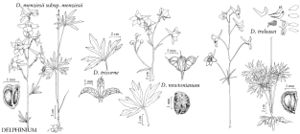Delphinium tricorne
Fl. Bor.-Amer., 314. 1803.
Stems 20-60 cm; base often reddish, nearly glabrous. Leaves mostly on proximal 1/3 of stem; basal leaves 0-4 at anthesis; cauline leaves 2-8 at anthesis; petiole 4-12 cm. Leaf-blade round, 2-8 × 4-12 cm, nearly glabrous; ultimate lobes 3-18, 5 or more extending more than 3/5 distance to petiole, width 2-10 mm (basal), 4-10 mm (cauline), widest at middle or in proximal 1/2. Inflorescences 5-15 (-30) -flowered, less than 3 times longer than wide; pedicel 1-2.5 cm, puberulent; bracteoles 1-4 (-6) mm from flowers, green, linear, 3-5 mm, puberulent. Flowers: sepals deep bluish purple to pink or white, puberulent, lateral sepals spreading, 11-19 × 4-7 mm, spurs straight, within 30° of horizontal, 13-16 mm; lower petal blades ± covering stamens, blue, except sometimes in white-flowered plants, 6-10 mm, clefts 0.5-2 mm; hairs sparse, mostly centered near junction of blade and claw, white. Fruits 14-22 mm, 4-4.5 times longer than wide, nearly glabrous. Seeds unwinged; surface of each seed-coat cell with 1-5 small, swollen, elongate, blunt, hairlike structures, barely visible at 20×, otherwise smooth. 2n = 16.
Phenology: Flowering spring.
Habitat: Slopes in deciduous forests, thicket edges, moist prairies
Elevation: 10-1500 m
Distribution

Ala., Ark., D.C., Ga., Ill., Ind., Iowa, Kans., Ky., Md., Miss., Mo., Nebr., N.C., Ohio, Okla., Pa., S.C., Tenn., Va., W.Va.
Discussion
Delphinium tricorne is the most commonly encountered larkspur east of the Great Plains.
The Cherokee prepared infusions of Delphinium tricorne to ingest for heart problems, although they believed the roots of the plant made cows drunk and killed them (D. E. Moerman 1986).
Selected References
None.
Lower Taxa
"widest" is not a number.
